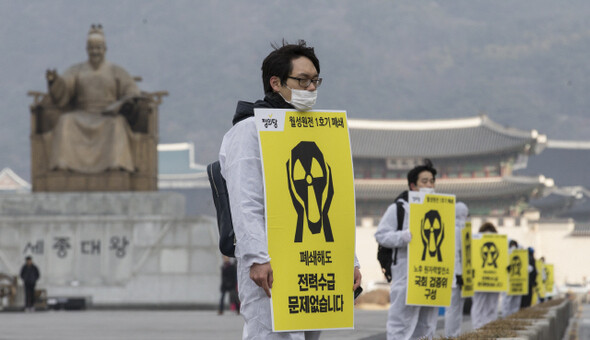hankyoreh
Links to other country sites 다른 나라 사이트 링크
[Editorial] Reconsider this dangerous decision about Wolseong reactor No. 1

Early in the morning of Feb. 27, while some of members were out of the room, the Nuclear Safety and Security Commission (NSSC) approved a motion to extend the lifespan of reactor no. 1 at the Wolseong Nuclear Plant. The decision means that the reactor, which had been shut down for three years following the end of its 30-year design lifespan, will be able to continue running through 2022.
Simply put, this is an unacceptable decision. The commission unilaterally pushed through a decision without resolving the safety issues that had been raised during the discussion. Surely safety is the most important consideration in operating a nuclear reactor! If the commission had learned the lesson of the accident at the Fukushima nuclear plant in Japan, it would not have made this rash decision.
We should not be surprised by the sharp backlash from environmental groups and residents of Yangnam Township in Gyeongju, North Gyeonsgang Province, the site of Wolseong Reactor No. 1.
Even setting aside the unbalanced composition of the commission, there were numerous problems with how the decision was made. Various allegations have been raised, including that the nuclear reactor safety standards that were created in 1991, known as R-7, have been applied to all other reactors, including Wolsoeng Reactors No. 2, No. 3, and No. 4, but not to Wolseong No. 1.
Given the risk of a nuclear accident, nothing about these reactors should have been handled carelessly. But most of the safety issues were not adequately resolved.
The commission members who voted to extend the reactor’s lifespan based their position that there were no problems on a report by the Korea Institute of Nuclear Safety (KINS), but this did not convince the opposing members of the commission. This means that, regardless of the commission members’ support for or opposition to nuclear power on a philosophical level, the arguments for extending the reactor’s lifespan were not robust on a technical level.
Two others issues that were not cleared up were the controversial decision not to apply the clause of the revised Atomic Energy Act about soliciting the opinion of residents of the area and alleged problems with the qualifications of some of the members of the commission. Despite this, the commission hurriedly rammed through the motion in the teeth of the opposition.
Disasters at Chernobyl in the former Soviet Union and Fukushima in Japan have taught us just how terrible these disasters can be. While the chances of disaster striking at a reactor may be low, when such a disaster does strike, the consequences are irreversible. Just because a reactor looks safe to us doesn’t mean that we can let our guard down.
Therefore, the commission must reconsider its decision. Speaking before the National Assembly on Feb. 27, Prime Minister Lee Wan-koo said that he partially agreed with questions that had been raised about using a vote to settle questions about public safety and security. We hope that Lee will take the lead on this issue.
The anxiety being felt by the 1.3 million people who live within a 30km radius of Wolseong Reactor No. 1 should drive us to take action.
Furthermore, the composition of the commission, which is currently largely filled with government officials and ruling party representatives, needs to be changed to reflect more diverse opinions. Only two of the nine members of the commission are appointed by the opposition party. What kind of balance is that?
Please direct questions or comments to [english@hani.co.kr]

Editorial・opinion
![[Column] Has Korea, too, crossed the Rubicon on China? [Column] Has Korea, too, crossed the Rubicon on China?](https://flexible.img.hani.co.kr/flexible/normal/500/300/imgdb/original/2024/0419/9317135153409185.jpg) [Column] Has Korea, too, crossed the Rubicon on China?
[Column] Has Korea, too, crossed the Rubicon on China?![[Correspondent’s column] In Japan’s alliance with US, echoes of its past alliances with UK [Correspondent’s column] In Japan’s alliance with US, echoes of its past alliances with UK](https://flexible.img.hani.co.kr/flexible/normal/500/300/imgdb/original/2024/0419/2317135166563519.jpg) [Correspondent’s column] In Japan’s alliance with US, echoes of its past alliances with UK
[Correspondent’s column] In Japan’s alliance with US, echoes of its past alliances with UK- [Editorial] Does Yoon think the Korean public is wrong?
- [Editorial] As it bolsters its alliance with US, Japan must be accountable for past
- [Guest essay] Amending the Constitution is Yoon’s key to leaving office in public’s good graces
- [Editorial] 10 years on, lessons of Sewol tragedy must never be forgotten
- [Column] A death blow to Korea’s prosecutor politics
- [Correspondent’s column] The US and the end of Japanese pacifism
- [Guest essay] How Korea turned its trainee doctors into monsters
- [Guest essay] As someone who helped forge Seoul-Moscow ties, their status today troubles me
Most viewed articles
- 1[Column] The clock is ticking for Korea’s first lady
- 2After 2 months of delayed, denied medical care, Koreans worry worst may be yet to come
- 3Hong Se-hwa, voice for tolerance whose memoir of exile touched a chord, dies at 76
- 4Samsung barricades office as unionized workers strike for better conditions
- 5[Column] Has Korea, too, crossed the Rubicon on China?
- 6US overtakes China as Korea’s top export market, prompting trade sanction jitters
- 7[Editorial] As it bolsters its alliance with US, Japan must be accountable for past
- 8[Correspondent’s column] In Japan’s alliance with US, echoes of its past alliances with UK
- 9All eyes on Xiaomi after it pulls off EV that Apple couldn’t
- 10[Guest essay] How Korea turned its trainee doctors into monsters